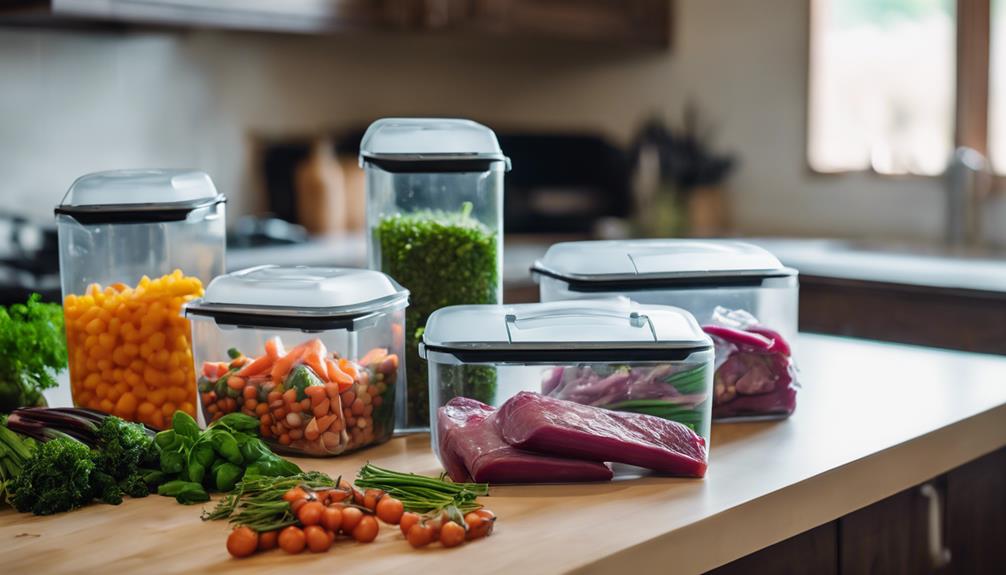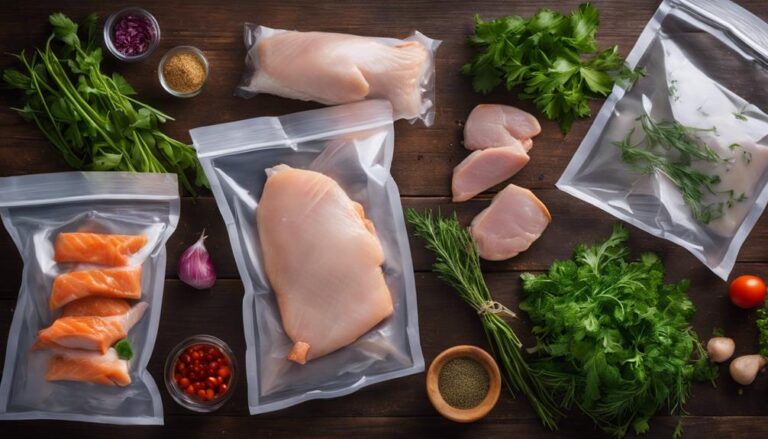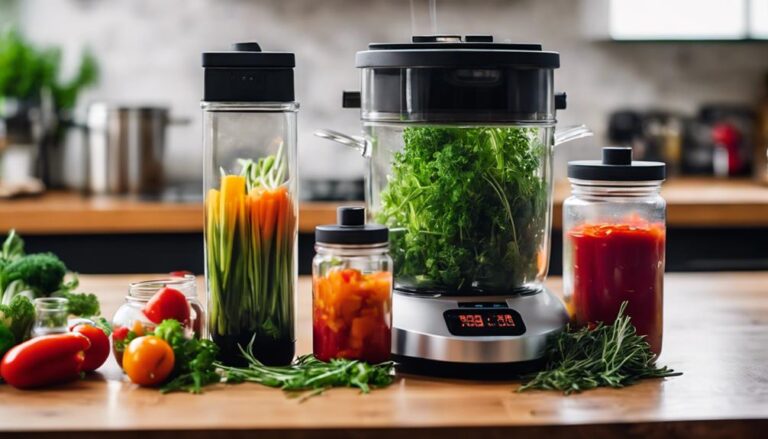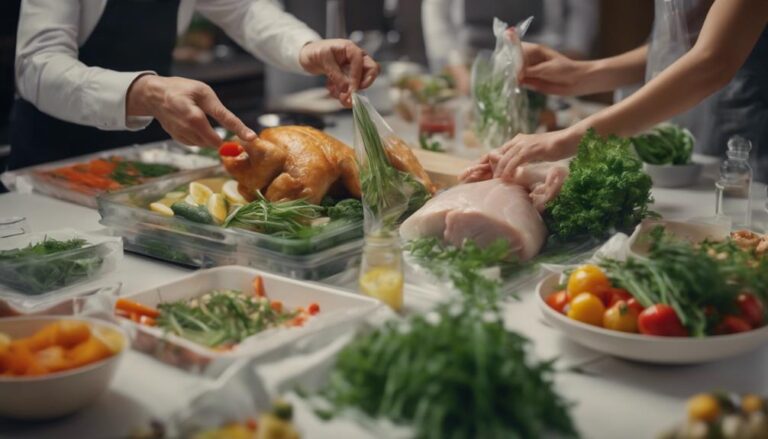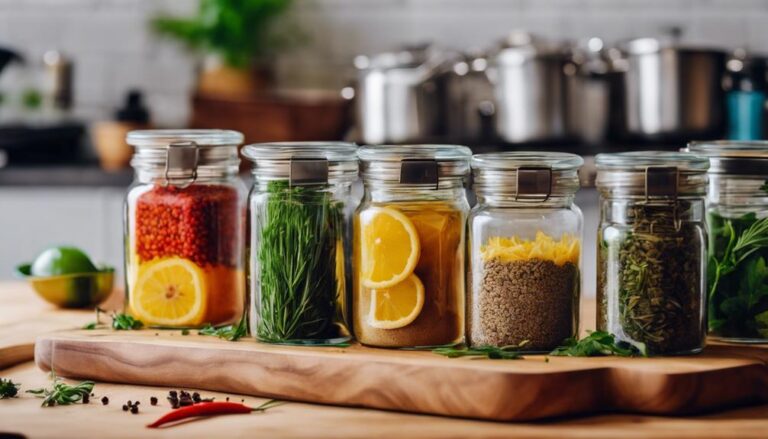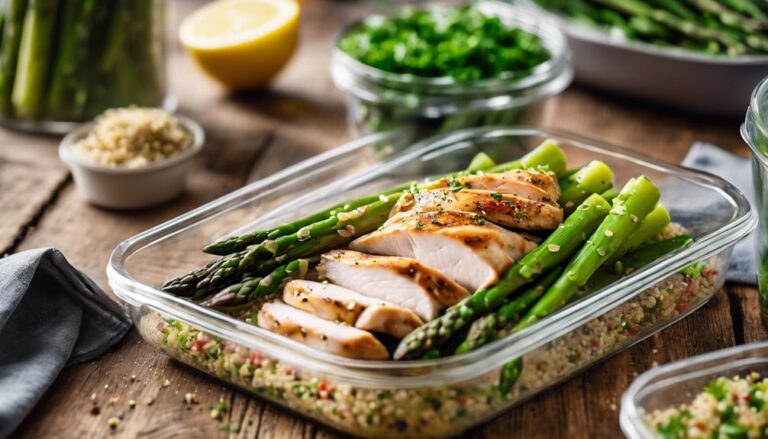How to Store and Reheat Sous Vide Meals for Weight Loss
To store sous vide meals for weight loss, vacuum-seal your portions and refrigerate them within two hours at 40°F or below. Properly stored meals can last up to two weeks in the fridge or six months in the freezer. For reheating, submerge the vacuum-sealed bags in a water bath for 20-30 minutes to maintain quality and tenderness. Alternatively, you can use a microwave or oven, but these methods may affect texture. Always monitor temperatures to guarantee food safety and avoid reheating multiple times. Carefully managing portion sizes with these techniques can support your weight loss goals effectively. Further tips follow.
What You Will Learn Here
- Store sous vide meals in vacuum-sealed bags or airtight containers, refrigerating for up to two weeks or freezing for up to six months.
- Quick chill meals in an ice bath to reduce bacterial growth, dropping the temperature below 70°F within two hours for safety.
- Portion meals before storage to manage serving sizes effectively, aiding in weight loss and preventing overindulgence.
- Reheat sous vide meals in a water bath for consistent temperature and texture, ensuring they maintain original flavor and tenderness.
Benefits of Sous Vide Storage
Storing sous vide meals properly not only keeps them fresh for weeks but also helps you enjoy nutritious, flavorful dishes whenever you want. By using proper storage techniques, like vacuum sealing individual portions, you can easily manage meal prep and portion control. This approach supports your weight loss goals while guaranteeing that your meals remain convenient and ready to serve.
After cooking, quick chilling your sous vide meals in an ice bath is essential. This method helps maintain freshness, preserving texture and flavor while minimizing the risk of bacterial growth. When stored correctly, sous vide meals can last in the refrigerator for up to two weeks or be frozen for up to six months without losing their nutrients and moisture.
When it's time to eat, reheating sous vide meals in the water bath allows for consistent temperature control. This guarantees your food remains tender and juicy, making it easier to stick to a satisfying diet.
Proper Cooling Techniques
To guarantee your sous vide meals remain safe and delicious, quick chilling them in an ice bath right after cooking is essential. This method helps bring the temperature down rapidly, minimizing bacterial growth and preserving food quality. Aim to drop the internal temperature below 70°F within two hours to confirm food safety, complying with health guidelines.
When using proper cooling techniques, consider dividing larger portions into smaller servings. This not only reduces cooling time but also promotes even temperature distribution, making it safer to serve. You should avoid leaving food at room temperature for longer than two hours, as this increases the risk of foodborne illness due to bacterial proliferation.
Once your meals are cooled, it's time to store sous vide meals correctly. Use vacuum-sealed bags or airtight containers to keep your meals fresh in the refrigerator for up to four days or in the freezer for up to six months.
Following these cooling techniques will help you maintain the quality and safety of your delicious sous vide creations, confirming that you can serve them with confidence to family and friends.
Freezing Sous Vide Meals
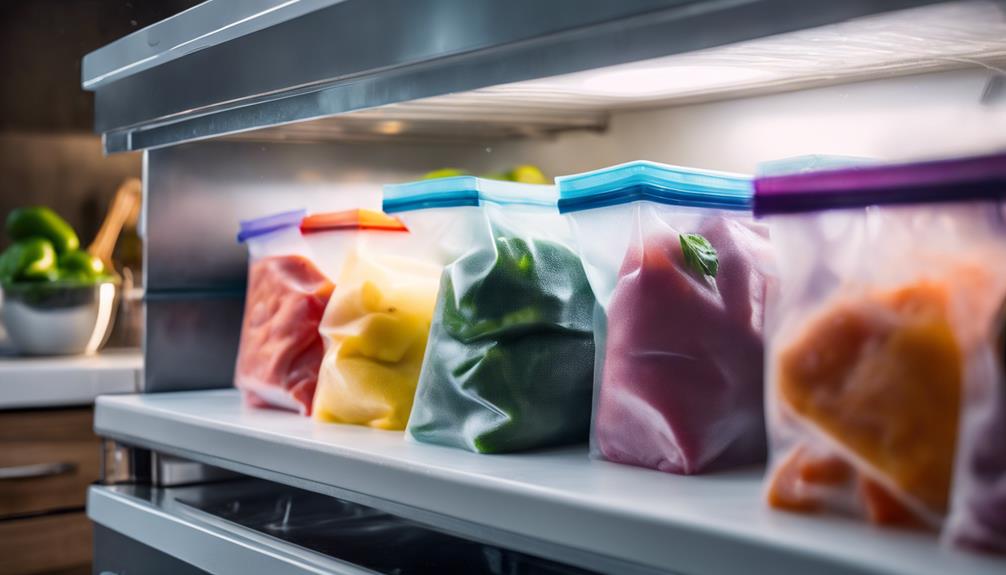
After you've cooled your sous vide meals properly, freezing them is a great way to preserve their taste and nutrients for later enjoyment. Quick chilling your cooked meals before freezing minimizes the risk of bacterial growth, guaranteeing food quality and safety.
To effectively store your meals, use vacuum-sealed pouches. These pouches are essential for freezing sous vide meals, as they prevent freezer burn and keep the integrity of the food intact.
If you're freezing raw sous vide items, consider seasoning them beforehand. This way, when you go through the reheating process, the flavors will be enhanced and ready to impress your guests. Properly frozen meals can last several months in the freezer, making them a convenient and healthy meal option that aligns with your weight loss goals.
When you're ready to enjoy these meals, just remember that the freezing process retains their nutrients and flavors, setting you up for success in meal planning. By preparing healthy, portion-controlled meals ahead of time, you'll not only save time but also guarantee that you're serving nutritious options to yourself and others.
Reheating Methods for Sous Vide
When it comes to reheating sous vide meals, using a water bath is one of the most effective methods.
You can simply return your food to the bath at its original cooking temperature, which usually takes about 20-30 minutes for ideal results.
For an added touch of flavor, consider searing your steak or chops in a hot skillet after warming them up, giving you that perfect crust while enhancing the taste.
Water Bath Reheating
Reheating sous vide meals in a water bath is a reliable method that preserves flavor and texture, ensuring your dishes taste just as delicious as when they were first cooked. This technique typically takes between 20 to 30 minutes, depending on the thickness and size of the food item.
For thicker cuts like roasts, you should reheat them at the original cooking temperature to maintain the right internal temperature while retaining moisture.
When you're working with smaller or thinner items, you have the option to either use the water bath or sear them quickly in a hot pan to bring them back to temperature while achieving a desirable crust.
If you're reheating seafood, it's best to place the cooled portions in the water bath at a lower temperature for about 30 to 45 minutes. This gentle approach helps maintain the seafood's texture and flavor, ensuring it doesn't become rubbery.
This method of reheating not only enhances the overall dining experience but also provides an opportunity to serve others with beautifully prepared sous vide meals that taste just as good as when they were first made.
Searing for Flavor
Searing sous vide meals enhances their flavor and texture, creating a delicious golden crust that elevates your dining experience. This final touch not only makes your dish visually appealing but also introduces the Maillard reaction, which deepens flavor and richness.
To achieve the best results, follow these guidelines:
- Sear reheated sous vide meats in a hot cast iron skillet with a small amount of oil or clarified butter for 1-2 minutes per side.
- For thicker items, reheat them in the sous vide bath at the original cooking temperature to maintain moisture and tenderness before searing.
- When reheating fish, place it back in a water bath at around 130°F for 30-45 minutes to retain its delicate texture, then give it a quick sear if desired.
Food Safety Guidelines
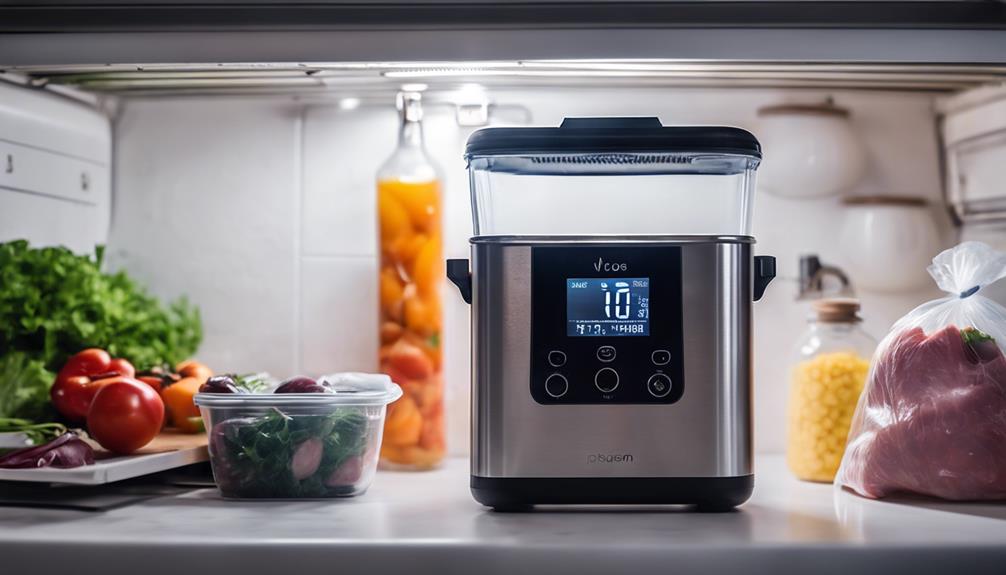
To keep your sous vide meals safe to eat, refrigerate them within two hours of cooking at a temperature of 40°F or below. Following these food safety guidelines is crucial to minimize foodborne illness risks. You can store cooked sous vide meals in the refrigerator for 3-4 days or freeze them for 6-12 months.
When you freeze sous vide meals, remember to thaw them in the refrigerator instead of at room temperature. This helps prevent harmful bacteria growth. Additionally, when reheating sous vide meals, it's important to maintain the original cooking temperature to guarantee safe pasteurization.
Utilizing quick chilling techniques, like an ice bath, right after cooking can also preserve food safety and quality. Here's a quick reference table to help you remember key points:
| Action | Recommendation |
|---|---|
| Refrigerate | Within 2 hours at 40°F or below |
| Refrigerator storage | 3-4 days |
| Freezing | 6-12 months |
| Thawing | In the refrigerator |
| Reheating | Maintain original cooking temperature |
Tips for Portion Control
Maintaining portion control is key to enjoying your sous vide meals while sticking to your dietary goals. By pre-portioning your meals, you can easily manage serving sizes and resist the urge to overeat.
Here are some effective tips for portion control:
- Use vacuum-sealed pouches to package individual servings of your sous vide meals.
- Label each pouch with the portion size and nutritional information to keep track of calorie intake.
- Incorporate a variety of vegetables in your meals to add volume and nutrition without greatly increasing calories.
These practices not only help you stay within your dietary goals but also facilitate meal planning, making it easier to serve others without overindulging.
By preparing meals in advance and sticking to designated portion sizes, you can enjoy your sous vide meals guilt-free.
Remember, it's all about balance and making informed choices that align with your weight loss journey.
With mindful portion control, you can serve delicious meals that satisfy your cravings while supporting your health objectives.
Frequently Asked Questions
How to Reheat Sous Vide Cooked Food?
To reheat sous vide cooked food, use stovetop sous vide or oven sous vide methods. Follow reheating time guidelines, ensuring proper reheating temperatures for flavor retention. Consider meal portioning tips for even warming and best reheating results.
Can You Eat Sous Vide Leftovers?
Yes, you can enjoy sous vide leftovers! They offer meal prep convenience, portion control, and maintain flavor retention. With proper food safety, reheating techniques, and texture improvement, you'll serve delicious, nutrient-preserved meals for others.
Can You Leave Food in the Bag After Cooking Sous Vide?
You can safely leave food in sous vide bags after cooking, provided you cool it quickly. This method enhances flavor infusion, guarantees temperature control, and showcases the benefits of sous vide techniques for efficient meal prep and food storage.
How to Freeze Sous Vide Meals?
To freeze sous vide meals effectively, use proper freezing techniques like vacuum sealing individual portions for flavor preservation. Focus on ingredient selection, label packages, and follow thawing tips for ideal meal prep and storage duration.
Conclusion
Storing and reheating sous vide meals can be an effective strategy for weight loss.
By using proper cooling and freezing techniques, you can maintain the quality of your meals while managing portion sizes.
When reheating, choose methods that preserve flavor and texture.
Always follow food safety guidelines to guarantee your meals are safe to eat.
With these tips in mind, you can enjoy delicious, healthy meals that fit your weight loss goals without sacrificing taste or convenience.
